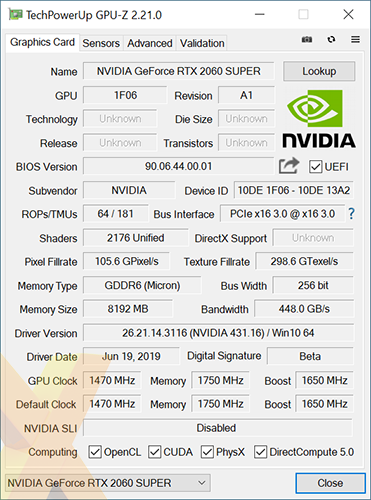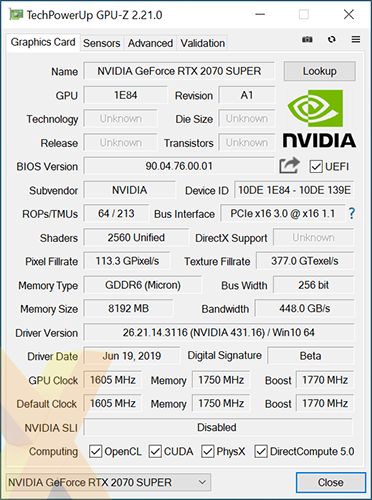Test Methodology
Nvidia GeForce RTX 2060 Super |
Nvidia GeForce RTX 2070 Super |
|---|---|
 |
 |
GPU Comparisons |
||||||||||
|---|---|---|---|---|---|---|---|---|---|---|
GPU |
Memory |
Miscellaneous |
||||||||
Cores |
Base (MHz) |
Boost (MHz) |
Type |
Size (MB) |
Clock (MHz) |
Bus (bits) |
Power Config |
Driver |
||
| Nvidia GeForce RTX 2080 Ti Founders Edition | 4,352 |
1,350 |
1,635 |
GDDR6 |
11,264 |
14,000 |
352 |
8+8 |
431.16 |
|
| Nvidia GeForce RTX 2080 Founders Edition | 2,944 |
1,515 |
1,800 |
GDDR6 |
8,192 |
14,000 |
256 |
6+8 |
431.16 |
|
| Nvidia GeForce RTX 2070 Super Founders Edition | 2,560 |
1,605 |
1,770 |
GDDR6 |
8,192 |
14,000 |
256 |
6+8 |
431.16 |
|
| Gigabyte GeForce RTX 2070 WindForce | 2,304 |
1,410 |
1,620 |
GDDR6 |
8,192 |
14,000 |
256 |
6+8 |
431.16 |
|
| Nvidia GeForce RTX 2060 Super Founders Edition | 2,176 |
1,470 |
1,650 |
GDDR6 |
8,192 |
14,000 |
256 |
8 |
431.16 |
|
| Nvidia GeForce RTX 2060 Founders Edition | 1,920 |
1,365 |
1,680 |
GDDR6 |
8,192 |
14,000 |
192 |
8 |
431.16 |
|
| MSI GeForce GTX 1080 Ti Gaming X Trio | 3,584 |
1,544 |
1,658 |
GDDR5X |
11,264 |
11,008 |
352 |
8+8 |
431.16 |
|
| AMD Radeon VII | 3,840 |
1,400 |
1,800 |
HBM2 |
16,384 |
1,000 |
4,096 |
8+8 |
19.7.1 |
|
| AMD Radeon RX Vega 64 | 4,096 |
1,247 |
1,546 |
HBM2 |
8,192 |
945 |
2,048 |
8+8 |
19.7.1 |
|
HEXUS Graphics Test Bench |
||
|---|---|---|
| Hardware Components | Product Page | |
| Processor | Intel Core i7-8700K (overclocked to 4.8GHz) | intel.com |
| CPU Cooler | Fractal Design Celsius S24 | fractal-design.com |
| Motherboard | Asus ROG Maximus X Hero | asus.com |
| Memory | G.Skill Trident Z 32GB (2x16GB) DDR4-3200 | gskill.com |
| Power Supply | be quiet! Dark Power Pro 11 1,000W | bequiet.com |
| Primary Storage | 256GB WD Black PCIe SSD | wdc.com |
| Secondary Storage | 1TB Crucial MX300 SATA SSD | crucial.com |
| Chassis | be quiet! Dark Base 700 | bequiet.com |
| Monitor | iiyama ProLite X4071UHSU-B1 | iiyama.com |
| Operating system | Windows 10 Pro 1903 | microsoft.com |
Benchmark Suite |
||
|---|---|---|
| Synthetic Benchmarks | ||
| 3DMark | Time Spy, Time Spy Extreme, Time Spy Extreme Stress Test | |
| Gaming Benchmarks and Settings | ||
| Civilization VI: Gathering Storm | DX12, 8xMSAA, Ultra Quality | |
| Far Cry: New Dawn | DX11, TAA, HD Textures Enabled, Ultra Quality | |
| Forza Horizon 4 | DX12, 8xMSAA, Maximum Quality | |
| Tom Clancy's The Division 2 | DX12, TAA, Ultra Quality | |
| Total War: Three Kingdoms | DX11, TAA, Ultra Quality | |
| World War Z | Vulkan, TAA, Ultra Quality | |
| World of Tanks enCore | DX11, TSSAA HQ, Ultra Quality | |
| General Benchmarks | ||
| Power Consumption | To emulate real-world usage scenarios, we record system-wide mains power draw both when idle and while playing Tom Clancy's The Division 2 | |
| Temperature | To emulate real-world usage scenarios, we record GPU core temperature both when idle and while playing Tom Clancy's The Division 2 | |
| Noise | A PCE-318 meter is used to record noise levels when idle and while playing Tom Clancy's The Division 2 | |
| Overclocking | Maintaining out-the-box voltage, we use the MSI's Afterburner to determine an optimal frequency curve while applying a manual memory overclock | |
Notes
We have tested nine cards from the ground up for this review. All were benchmarked on the latest drivers as of June 29, 2019, and Windows was updated and all games patches were applied, as well.
Having new cards gives us the opportunity of debuting games into the suite and changing the quality settings so they are even more stringent. You'll notice that Civilization VI has been updated to the Gathering Storm DLC, Far Cry now uses New Dawn, while Total War carries the more intensive Three Kingdoms benchmark. There's also World War Z, ostensibly for Vulkan performance, and, because we enjoy it, The Division 2.









